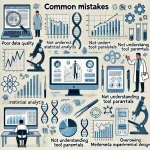
The Real-world Impact of Bioinformatics: Case Studies Exploring Successes and Pitfalls
August 24, 2023Part 1: Opening Remarks
Bioinformatics operates at the crossroads of biology and computational science, holding immense promise for transforming medical research, pharmaceutical advancements, and more. But what occurs when its forecasts miss the mark, or conversely, hit the bullseye? This article aims to dissect real-world instances to comprehend the practical benefits, victories, and limitations of bioinformatics.
Part 2: The Triumph of Drug Reassignment
A standout illustration of bioinformatics’ practical value lies in drug reassignment. Computational methods can scan existing drug databases to identify medications that could be repurposed for new applications. For instance, Remdesivir, initially designed for Ebola, was later found effective for COVID-19 treatment through bioinformatics scrutiny.
Part 3: Tailored Medical Treatments
Bioinformatics plays a pivotal role in the rise of personalized medicine. Genetic data can inform treatment strategies for ailments like cancer, resulting in more targeted and less harmful interventions. The case of Herceptin, a breast cancer medication, is noteworthy; it shows heightened effectiveness in patients with specific genetic markers.
Part 4: The Downside of Erroneous Forecasts
Bioinformatics is not devoid of shortcomings. Early studies in the field mistakenly suggested that certain BRCA1 gene mutations were harmless. Women with these mutations skipped preventive measures, leading to avoidable instances of breast and ovarian cancer.
Part 5: Moral Dilemmas
Though not a case study, the ethical implications of using bioinformatics for disease predisposition predictions cannot be ignored. Inaccurate forecasts can induce undue stress or needless medical procedures, while accurate ones may lead to insurance discrimination.
Part 6: Future Prospects and Limitations
The practical relevance of bioinformatics is undeniable, but its constraints are equally significant. As computational techniques advance and data pools expand, prediction accuracy is likely to improve. Nonetheless, this doesn’t negate the necessity for rigorous validation and ethical contemplation.
Part 7: Summing Up
Bioinformatics has had a substantial real-world impact, from drug reassignment to individualized medicine. However, its potential for error underscores the need for both validation and ethical scrutiny. As the discipline progresses, harmonizing its potential with its pitfalls will be essential.
Part 8: A Case for Rigorous Validation
A quintessential case study emphasizing validation necessity involved an algorithm for predicting sepsis patient outcomes. While initial results were promising, the algorithm faltered in actual clinical settings, failing to accurately forecast patient outcomes. This served as an eye-opener regarding the limitations of relying solely on computational predictions without thorough validation.
Part 9: Progress in Evolutionary Studies
Bioinformatics is also revolutionizing how we approach evolutionary biology. The iconic study of Darwin’s finches in the Galápagos Islands took a computational twist when researchers sequenced the genomes of various finch species. This offered unparalleled insights into the genes shaping the birds’ beak forms, reinforcing Darwin’s theories at a molecular level.
Part 10: Agricultural Advances
Another practical use case is in agriculture, where bioinformatics aids in plant genome studies. For instance, insights into the rice genome have led to the creation of more drought-resistant strains, positively affecting food security.
Part 11: The Weight of Accountability
The repercussions of incorrect bioinformatics predictions extend beyond academic discussions; they have tangible consequences. There are instances where bioinformatics tools miss drug interactions, leading to unfavorable results. Recognizing the gravity of its responsibilities is crucial for the field.
Part 12: Regulatory Oversight
With increased capabilities comes the need for regulatory frameworks. Organizations like the FDA in the United States are starting to outline guidelines for bioinformatics applications in medical research and treatment. These aim to ensure that tools meet reliability and accuracy standards before influencing critical decisions.
Part 13: Striking a Balance
The meteoric rise of bioinformatics comes with the challenge of aligning computational innovations with biological insights. Algorithmic models can sometimes act as “black boxes,” making it vital to understand their limitations for practical applications.
Part 14: Final Thoughts
Bioinformatics serves as a tool rather than a panacea. Its real-world applications are diverse and expanding, from pharmaceutical innovations to personalized healthcare. Yet the discipline faces its own set of challenges and ethical quandaries. As technology evolves, so must our grasp of its potential, limitations, and societal implications.
This wraps up our comprehensive examination of the practical facets, triumphs, and challenges of bioinformatics. Whether it’s revolutionizing healthcare or contributing to global food security, the field is making significant strides, albeit with a few cautionary notes along the way.

















